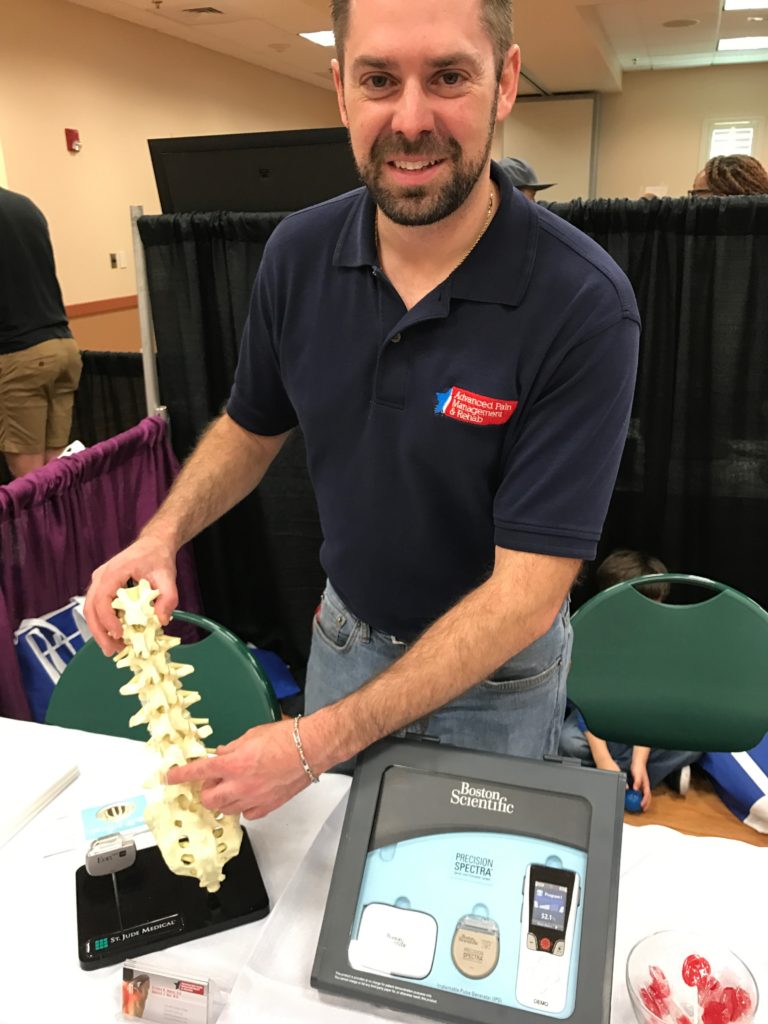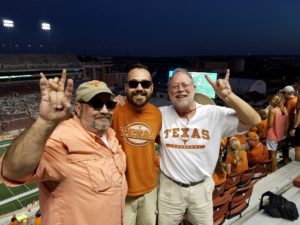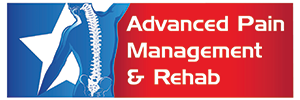
blog written by Kristen McFarland of Savvy Media, for Advanced Pain Management
Just 5 years ago, Bob DuPriest wasn’t enjoying his life, as he dealt with chronic pain that kept him from doing the things he loved most. A neurosurgeon told Bob he was just one small accident from being paralyzed and confined to a wheel chair for the rest of his life. His cumulative neck and back injuries from sports and car accidents were so severe that he was experiencing numbness in his hands and feet as well as trembling in his hands. It was so bad at times, that items would jerk out of his hands and go flying. But worse than the numbness and trembling was a daily debilitating headache that left him unable to do anything after 3:00 in the afternoon. A neurosurgeon told Bob that surgery was necessary not only to alleviate his symptoms but to also stop progression of the injuries that would eventually lead to his paralyzation.
After 2 long years of fusion surgeries for his neck and back, Bob was finally relieved of his headaches and the numbness in his hands and feet. However, the surgeries had released his nerves and left him a new and different pain in his lower back that prevented him from completing rehabilitation. Even worse, he was on a narcotic cocktail of 36 pills a day just to get by. “Not only do the prescriptions numb the pain, they numb the enjoyment of anything you are doing – I don’t think the pills make the pain go away, they just makes you forget about it,” Bob recalls.
Life felt miserable to Bob. That is, until he met Dr. Stephen Dinger.
Dr. Stephen Dinger of Advanced Pain Management and Rehab offered Bob an alternative treatment plan. It was a possible solution that included Spinal Cord Stimulation.

“It was a complete life changer,” Bob says.
Spinal Cord Stimulation (SCS) delivers a mild electrical stimulation to the nerves in the spinal column, interrupting pain signals as they travel to the brain. The therapy is for patients with back or neck neurological conditions who experience chronic pain. While SCS has been a treatment option since 1967, recent breakthroughs and innovations in the therapy have made it a front runner treatment option for patients living in constant pain. But perhaps the best part is that this non-medicinal therapy provides a huge benefit for patients with little risk or side effects.
“This is an opportunity to ease patient pain earlier in the healing process,” says Dr. Dinger. He says the Spine Cord Stimulator is a treatment that should be considered at the same time as narcotics and surgery. “It’s no longer a last resort.”
How does it work? A small device is implanted near the spine that generates pulses to prevent pain. The device is controlled remotely. The patient is able to choose custom programs to fit his or her different activity level, providing real time pain relief. Even better, patients usually see a reduction in their pain meds. With recent healthcare initiatives focusing on reducing the amount of narcotics prescribed, Spine Cord Stimulation provides an alternate option that is now covered by most insurance providers. Unlike most pain treatments, SCS can be tried for a short time before a person commits to having the implant. If the trial is successful, the device can be implanted with a simple outpatient procedure. Also, due to increased competition among SCS device manufacturers, there have been several new innovations with the device technology allowing physicians like Dr. Dinger to offer more custom options to patients, which in turn, opens treatment options for patients who, in the past, may not have been considered as a successful candidate.

Bob with friends enjoying life without pain thanks to his SCS implant
“Instant relief” is how Bob recalls his trial with SCS. Bob was able to stop all pain medicine and get back on track with physical therapy. Not only did his health improve but his quality of life got better too. With his mind clear of medicine fog once caused by pills, he was even able to finish his practicum to earn his Licensed Nurses Facility Administrator (LNFA), and today, runs nursing homes. “I’m enjoying life and that is the difference between the pills and the Spinal Cord Stimulator,” explains Bob.
As Bob gets ready to celebrate his 60th birthday next month, he feels better than he did at 50! In addition to working, he has returned to his hobbies of fishing and shooting activities. Bob has gone from hardly being able to leave his house to even running a 5K not too long ago with this life changing device.
“If you want to remember yesterday and look forward to tomorrow, [Spinal Cord Stimulation] is the difference. It brought my life back to me.”

For a consultation to see if SCS might be a treatment option, call Dr. Dinger at (210) 495-7246, or, contact his team at info@backpainsa.com. Dr. Dinger is triple board certified and has offices in the Stone Oak area and Schertz, TX.
